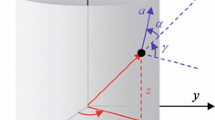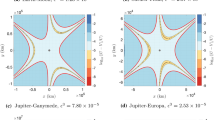Abstract
Quasi-terminator orbits are introduced as a class of quasi-periodic trajectories in the solar radiation pressure (SRP) perturbed Hill dynamics. These orbits offer significant displacements along the Sun-direction without the need for station-keeping maneuvers. Thus, quasi-terminator orbits have application to primitive-body mapping missions, where a variety of observation geometries relative to the Sun (or other directions) can be achieved. This paper describes the characteristics of these orbits as a function of normalized SRP strength and invariant torus frequencies and presents a discussion of mission design considerations for a global surface mapping orbit design.












Similar content being viewed by others
Notes
References are given when available, otherwise the parameters have been approximated using the authors’ best guess. In the latter cases, the \(\approx \) symbol is used before the numerical data given.
Generally, perturbations in the span of the center manifold evolve on a invariant torus described by three frequencies. This more general motion is not explored in this paper. The two 4-D sub-manifolds of invariant tori studied here are invariant slices in this larger quasi-periodic space. The method used to follow the tori in Eq. 9 ensures that the tori found lie on a sub-manifold where motion is described by only two frequencies.
This is true, but for low \(m/n\) ratios (\(\ne 1\)), this stability seems to be marginal in a non-linear sense. When such a solution to the multiple-shooting corrector algorithm is re-propagated as a single trajectory, the match between starting and ending states is often noticeably less accurate than usual.
Recall from Sect. 5.4 that if \(C\) is larger than the maximum \(C\) for the corresponding terminator family, the quasi-terminator orbits near the RTO are not embedded in the center manifold of the terminator orbit, and thus, do not necessarily have consistent geometries with those shown in Figs. 5 and 6.
This may not be the case for some RTO families at low \(\beta \) values, but RTOs are not usually of interest in these dynamical scenarios because the orbit periods are very long. Further, for small \(\beta \), the dominant perturbation is often the irregular gravity of the primitive body, which is a scenario where the assumptions in this work do not apply.
In a real mission application, this minimum radius should be carefully chosen based on factors including primitive body mass distribution, orbit maintenance frequency, and duration in orbit.
The Sun-relative geometry describes the relative geometry between the orbiting spacecraft, primitive-body center-of-mass, and the Sun. It is independent of the motion of the primitive body surface. As such, actual global surface mapping performance for a particular orbit depends upon the body spin orientation and state.
References
Abe, S., Mukai, T., Hirata, N., Barnouin-Jha, O.S., Cheng, A.F., Demura, H., Gaskell, R.W., Hashimoto, T., Hiraoka, K., Honda, T., Kubota, T., Matsuoka, M., Mizuno, T., Nakamura, R., Scheeres, D.J., Yoshikawa, M.: Mass and local topography measurements of Itokawa by Hayabusa. Science 312, 1344–1347 (2006)
Baer, J., Chesley, S.: Astrometric masses of 21 asteroids, and an integrated asteroid ephemeris. Celest. Mech. Dyn. Astron. 100, 27–42 (2008)
Broschart, S.B., Villac, B.F.: Identification of non-chaotic terminator orbits near 6489 Golevka. Adv. Astron. Sci. 134, 861–880 (2009)
Broschart, S.B., Scheeres, D.J., Villac, B.F.: New families of multi-revolution terminator orbits near small bodies. Adv. Astron. Sci. 135, 1685–1702 (2010)
Broucke, R.A.: Stability of periodic orbits in the elliptic restricted three-body problem. AIAA J. 7, 1003–1009 (1969)
Chesley, S.R., Nolan, M.C., Farnocchia, D., Milani, A., Emery, J., Vokrouhlicky, D., Lauretta, D.S., Taylor, P.A., Benner, L.A.M., Giorgini, J.D., Brozovic, M., Busch, M.W., Margot, J.-L., Howell, E.S., Naidu, S.P., Valsecchi, G.B., Bernardi, F.: The trajectory dynamics of near-Earth Asteroid 101955 (1999 RQ36). LPI Contrib. 1667, 6470 (2012)
Dankowicz, H.: Some special orbits in the two-body problem with radiation pressure. Celest. Mech. Dyn. Astron. 58, 353–370 (1994)
Demura, H., Kobayashi, S., Nemoto, E., Matsumoto, N., Furuya, M., Yukishita, A., Muranaka, N., Morita, H., Shirakawa, K., Maruya, M., Ohyama, H., Uo, M., Kubota, T., Hashimoto, T., Kawaguchi, J., Fujiwara, A., Saito, J., Sasaki, S., Miyamoto, H., Hirata, N.: Pole and global shape of 25143 Itokawa. Science 312, 1347–1349 (2006)
Glassmeier, K.-H., Boehnhardt, H., Koschny, D., Kührt, E., Richter, I.: The Rosetta mission: flying towards the origin of the solar system. Space Sci. Rev. 128, 1–21 (2007)
Gómez, G., Mondelo, J.M.: The dynamics around the collinear equilibrium points of the RTBP. Physica 154, 283–321 (2001)
Hasegawa, S., Müller, T.G., Kawakami, K., Kasuga, T., Wada, T., Ita, Y., Takato, N., Terada, H., Fujiyoshi, T., Abe, M.: Albedo, size, and surface characteristics of Hayabusa-2 sample-return target 162173 1999 JU3 from AKARI and Subaru observations. Publ. Astron. Soc. Jpn. 60, 399 (2008)
Howell, K.C., Breakwell, J.V.: Almost rectilinear halo orbits. Celest. Mech. 6, 29–52 (1984)
JPL SSD Group: JPL small-body database browser. National Aeronautics and Space Administration Jet Propulsion Laboratory. http://ssd.jpl.nasa.gov/sbdb.cgi (2012). Accessed Sept 2012
Keller, H.B.: Numerical solution of bifurcation and nonlinear eigenvalue problems. In: Rabinowitz, P. (ed.) Numerical Solution of Bifurcation and Nonlinear Eigenvalue Problems. Academic Press, New York (1977)
Kolemen, E., Kasdin, N., Gurfil, P.: Multiple Poincar sections method for finding the quasiperiodic orbits of the restricted three body problem. Celest. Mech. Dyn. Astron. 112, 47–74 (2012)
Lamy, P.L., Toth, I., Weaver, H.A., Jorda, L., Kaasalainen, M., Gutiérrez, P.J.: Hubble space telescope observations of the nucleus and inner coma of comet 67P/Churyumov–Gerasimenko. Astron. Astrophys. 458, 669–678 (2006)
Lauretta, D.S., The OSIRIS-Rex Team: An overview of the OSIRIS-REx asteroid sample return mission. In: Lunar and Planetary Institute Science Conference Abstracts, vol. 43, p. 2491 (2012)
Leimkuhler, B., Reich, S.: Simulating Hamiltonian Dynamics, vol. 1. Cambridge University Press, New York (2004)
Liu, Y.-Y., Villac, B.: Periodic orbit families in the Hill’s three-body problem with solar radiation pressure. Adv. Astron. Sci. 136, 285–300 (2010)
Miller, J.K., Konopliv, A.S., Antreasian, P.G., Bordi, J.J., Chesley, S., Helfrich, C.E., Owen, W.M., Wang, T.C., Williams, B.G., Yeomans, D.K.: Determination of shape, gravity, and rotational state of asteroid 433 Eros. Icarus 155, 3–17 (2002)
Montenbruck, O., Gill, E.: Satellite Orbits: Models, Methods, Applications. Springer, Berlin (2001)
NASA Near Earth Object Program: 2000 SG344 impact risk. National Aeronautics and Space Administration. http://neo.jpl.nasa.gov/risk/2000sg344.html (2012). Accessed Oct 2012
Nolan, M.C., Magri, C., Howell, E.S., Benner, L.A.M., Giorgini, J.D., Hergenrother, C.W., Hudson, R.S., Lauretta, D.S., Margot, J.-L., Ostro, S.J., Scheeres, D.J.: Shape model and surface properties of the OSIRIS-REx target Asteroid (101955) Bennu from radar and lightcurve observations. Icarus 226, 629–640 (2013)
Olikara, Z.P., Scheeres, D.J.: Numerical methods for computing quasi-periodic orbits and their stability in the restricted three-body problem. Presented at the 1st IAA Conference on Dynamics and Control of Space Systems, Paper 08–10 (2010)
Scheeres, D.J.: Satellite dynamics about asteroids. Adv. Astron. Sci. 87, 275–292 (1994)
Scheeres, D.J.: Satellite dynamics about small bodies: averaged solar radiation pressure effects. J. Astron. Sci. 47, 25–46 (1999)
Scheeres, D.J., Marzari, F.: Spacecraft dynamics in the vicinity of a comet. J. Astron. Sci. 50, 35–52 (2002)
Scheeres, D.J.: Orbit mechanics around asteroids and comets. J. Guid. Control Dyn. 35, 987–997 (2012)
Thomas, P.C., Binzel, R.P., Gaffey, M.J., Storrs, A.D., Wells, E., Zellner, B.H.: Impact excavation on asteroid 4 vesta: hubble space telescope results. Science 277, 1492–1495 (1997)
Villac, B.F., Broschart, S.B.: Applications of chaoticity indicators to stability analysis around small bodies. Adv. Astron. Sci. 134, 1813–1832 (2009)
Yoshikawa, M., Minamino, H., Tsuda, Y., Abe, M., Nakazawa, S., The Hayabusa2 Project Team: Hayabusa2—New challenge of next asteroid sample return mission. LPI Contrib. 1667, 6188 (2012)
Acknowledgments
The work described in this paper was carried out at the Jet Propulsion Laboratory, California Institute of Technology, under a contract with the National Aeronautics and Space Administration. The authors thank Zubin Olikara for the insights he shared with us on torus computation and the dynamical structure of this problem. They also thank Benjamin Villac for some early discussions on the dynamical structure around terminator orbits that led to this work. The authors further thank Benjamin and Roby Wilson for their helpful comments on a draft manuscript.
Author information
Authors and Affiliations
Corresponding author
Rights and permissions
About this article
Cite this article
Broschart, S.B., Lantoine, G. & Grebow, D.J. Quasi-terminator orbits near primitive bodies. Celest Mech Dyn Astr 120, 195–215 (2014). https://doi.org/10.1007/s10569-014-9574-3
Received:
Revised:
Accepted:
Published:
Issue Date:
DOI: https://doi.org/10.1007/s10569-014-9574-3




